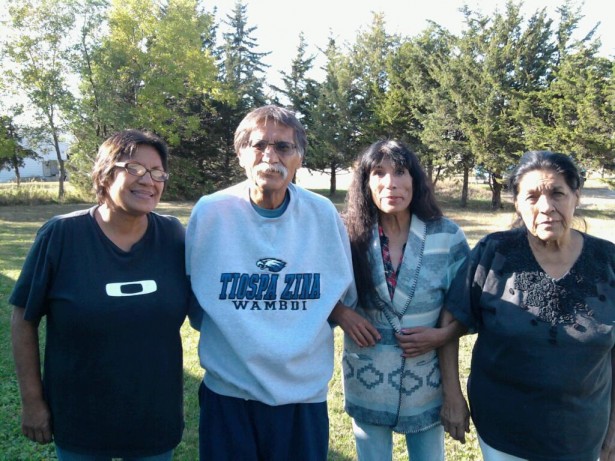By Stephanie Woodard
Indian Country Today Media Network
October 7, 2011
http://indiancountrytodaymedianetwork.com/2011/10/sisseton-wahpeton-oyate-passes-landmark-sexual-abuse-statute/
 |
| Shortly after the Sisseton Wahpeton Oyate council passed its new childhood-sexual-abuse statute law on September 27 the Wanna family gathered to express their relief with the announcement. Pictured, from left, are Patricia, Howard, Mary Jane and Sandy. |
“We’re so relieved,” said Mary Jane Wanna, 65, of the Sisseton Wahpeton Oyate council’s passage of a new childhood-sexual-abuse statute, which will allow tribal members to file claims in tribal court. The council approved the measure on September 27, after an energetic four-month campaign by Wanna and other elders, who have alleged they were abused as youngsters while attending a Catholic Church-run residential facility for tribal children. The ordinance provides another legal option for those affected by the South Dakota legislature’s 2010 state law—HB1104—which restricts civil claims for childhood sexual abuse by those over 40.
The Sisseton Wahpeton law is the first of its type in the country, according to Vito De La Cruz, Yaqui, an attorney with Tamaki Law, a Washington State firm that was instrumental in the recent $166-million settlement reached with the Jesuits on behalf of hundreds of former students who had charged abuse at the religious order’s schools in the Northwest and Alaska. “All tribes have criminal child-sex-abuse statutes, but this is the first civil one and allows plaintiffs whose cases have been dismissed in other jurisdictions to file in tribal court,” said De La Cruz, who added that both state and federal courts honor tribal court judgments.
“Sisseton Wahpeton is giving its tribal members their day in court—in their own court,” said Ken Bear Chief, Gros Ventre/Nez Perce/Nooksak, an investigator and paralegal with Tamaki Law. “It is within tribes’ power to hear personal-injury claims against organizations that operated within their boundaries.”
Wanna and others—including her brother Howard, 60, who is dying of cancer and regards his efforts as a way to protect further generations—have advocated for the change since early this past summer. They buttonholed Sisseton Wahpeton officials and talked up the statute at district gatherings, elders’ groups, tribal council meetings, a public forum and even the grocery store, said Mary Jane.
“I told one councilor we’re always throwing around the word oyate—meaning ‘my people, our people.’ And I said to him, ‘I’m your people,’ ” she recalls. “He told me not to worry. Now I hope every other reservation in South Dakota follows suit with a law of their own. It can and should be done.”
When Sisseton Wahpeton’s tribal council agreed to turn its attention to the issue earlier this year, Mary Jane’s sister Patricia, 61, was elated, saying, “Finally, we’re someone. We’re not ‘nothing’ anymore.” Now, Patricia said, “I feel a weight off my shoulders.”
Critics of HB1104, including Robert Brancato, head of South Dakota’s chapter of the national advocacy group Survivors Network of Those Abused by Priests (SNAP), have alleged bias. Brancato has noted that the 2010 bill followed a wave of 100-some Native American lawsuits in the state against the Church and its South Dakota boarding schools. The Native plaintiffs are virtually all over 40 because of the time period during which the Church ran the now-notorious facilities. Claims by the Wannas and others at Sisseton Wahpeton are now before a South Dakota state court that has already used HB1104 to nix lawsuits arising from St. Paul’s Indian Mission, in Marty, South Dakota.
The Church thought its problems were over, said Howard Wanna: “But they’re not. We passed this law, and the lawsuits will let the world know we were molested and tortured. The abuse affected every family on this reservation. We went through hell.”
Any original material on these pages is copyright © BishopAccountability.org 2004. Reproduce freely with attribution.